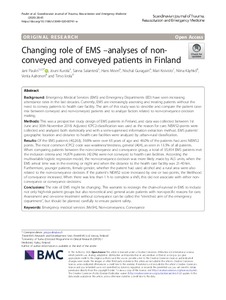Changing Role of EMS -Analyses of Non-Conveyed and Conveyed Patients in Finland
Paulin J; Moen H; Salanterä S; Guragain N; Käyhkö N; Koivisto M; Iirola T; Kurola J; Aaltonen V
https://urn.fi/URN:NBN:fi-fe2021042822299
Tiivistelmä
Abstract
Background: Emergency Medical Services (EMS) and Emergency Departments (ED) have seen increasing
attendance rates in the last decades. Currently, EMS are increasingly assessing and treating patients without the
need to convey patients to health care facility. The aim of this study was to describe and compare the patient casemix between conveyed and non-conveyed patients and to analyze factors related to non-conveyance decision
making.
Methods: This was a prospective study design of EMS patients in Finland, and data was collected between 1st
June and 30th November 2018. Adjusted ICPC2-classification was used as the reason for care. NEWS2-points were
collected and analyzed both statistically and with a semi-supervised information extraction method. EMS patients’
geographic location and distance to health care facilities were analyzed by urban–rural classification.
Results: Of the EMS patients (40,263), 59.8% were over 65 years of age and 46.0% of the patients had zero NEWS2
points. The most common ICPC2 code was weakness/tiredness, general (A04), as seen in 13.5% of all patients.
When comparing patients between the non-conveyance and conveyance group, a total of 35,454 EMS patients met
the inclusion criteria and 14,874 patients (42.0%) were not conveyed to health care facilities. According the
multivariable logistic regression model, the non-conveyance decision was more likely made by ALS units, when the
EMS arrival time was in the evening or night and when the distance to the health care facility was 21-40 km.
Furthermore, younger patients, female gender, whether the patient had used alcohol and a rural area were also
related to the non-conveyance decision. If the patient’s NEWS2 score increased by one or two points, the likelihood
of conveyance increased. When there was less than 1 h to complete a shift, this did not associate with either nonconveyance or conveyance decisions.
Conclusions: The role of EMS might be changing. This warrants to redesign the chain-of-survival in EMS to include
not only high-risk patient groups but also non-critical and general acute patients with non-specific reasons for care.
Assessment and on-scene treatment without conveyance can be called the “stretched arm of the emergency
department”, but should be planned carefully to ensure patient safety.
Keywords: Emergency medical services [MeSH], Non-conveyance, Conveyance
Kokoelmat
- Rinnakkaistallenteet [19217]
